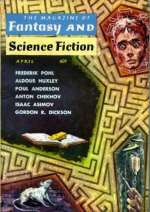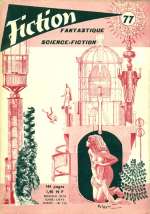|  
 | | | |  The story also appeared in this 2003 collection. The story also appeared in this 2003 collection. | | “The Willow Tree”
by Jane Rice
First publication: The Magazine of Fantasy and Science Fiction, Feb 1959

By my count, this is the fifth time travel story in the February 1959 issue of F&SF, which is a record. Maybe they were anticipating the release of The Time Machine in the subsequent year.

In this story, four orphans are sent to live in the past with the rather odd Aunt Martha and the slightly less odd Aunt Harriet, who together give the children only one commandment: Never play under the willow tree! When the four O When the four O :: children, Lucy, Robert, Charles, and May, were orphaned by a freak of circumstances, they were sent to live in the Past with two spinster relatives, ostensibly because of crowded conditions elsewhere. 
| |
| | | | |

 
 
 | | | | 

| | “Unto the Fourth Generation”
by Isaac Asimov
First publication: The Magazine of Fantasy and Science Fiction, Apr 1959

During an ordinary day of business, Sam Marten is obsessivly drawn to different men named Levkowich, each with a different spelling.

When I began putting together this Big List in 2005, I started with all the Asimov time travel stories that I could remember. Somehow I forgot about this story which I first read in 1973 in Nightfall and Other Stories. But then, while scouring the 1950s back issues of F&SF for more obscure stories, there it was: Sam Marten’s great, great grandfather brought from his deathbed to meet Sam, and there, also, was a moment of time travel for Sam himself.

Two new sentences were added at the end of the original story for the reprinting in Asimov’s collection, so I thought it would be appropriate to quote those new sentences here: Yet somehow he knew that all would be well with him. Somehow, as never before, he knew. Yet somehow he knew that all would be well with him. Somehow, as never before, he knew. 
| |
| | | | |

 
 | | | |  The story also appeared in the Apr 1960 issue of this French story magazine. The story also appeared in the Apr 1960 issue of this French story magazine. | | “Tenth Time Around”
by J.T. McIntosh
First publication: The Magazine of Fantasy and Science Fiction, May 1959

 Gene Player seems destined to always lose his love Belinda to his friend Harry Scott, but maybe, just maybe, he’ll get it right on the tenth time around as he’s once again sent back to his 1975 body in this branching universe time travel story. But what if in the new 1975, he meets young Doreen for the first time, not to mention those other small things that go differently? Gene Player seems destined to always lose his love Belinda to his friend Harry Scott, but maybe, just maybe, he’ll get it right on the tenth time around as he’s once again sent back to his 1975 body in this branching universe time travel story. But what if in the new 1975, he meets young Doreen for the first time, not to mention those other small things that go differently? It was a big decision, the first time. If you were at all successful in life at forty, fifty, sixth, the glorious thought of being young again, strong, healthy and probably in love, was considerably tempered by the consideration that you’d be pushed around again, that you’d have to get up at seven and work hard all day for less than a tenth of what you made now, that you’d have to go through this or that operation again, that you’d have to see your father and mother die again . . . It was a big decision, the first time. If you were at all successful in life at forty, fifty, sixth, the glorious thought of being young again, strong, healthy and probably in love, was considerably tempered by the consideration that you’d be pushed around again, that you’d have to get up at seven and work hard all day for less than a tenth of what you made now, that you’d have to go through this or that operation again, that you’d have to see your father and mother die again . . . 
| |
| | | | |

 
 
| |     |